Goss's Bacterial Wilt Technical Bulletin
What is Goss’s Wilt?
In 1969 Goss’s Bacterial Wilt was first identified in three fields near Lexington, Nebraska. Kansas, Colorado, Wyoming, South Dakota, Iowa, Illinois and Wisconsin are some additional states where this disease has now been identified. For years this disease had not been a serious problem but in the last several years it has re‐emerged as a major concern and, in some cases, a yield robbing threat for some producers to deal with.
The bacterium which causes Goss’s Wilt survives by overwintering on infected crop residue. Goss’s Wilt is not insect transmitted like Stewart’s Wilt but relies on the plant being wounded for disease distribution. Events like hail damage, sand blasting and wind‐driven rains are examples of how this disease can enter into the plant. Studies at the University of Nebraska have also shown that the bacteria is capable of being both seedborne and seed transmitted. The spread of this pathogen is enhanced by continuous corn and the infected residue that can be blown about. The pathogen can cause two major types of symptoms:
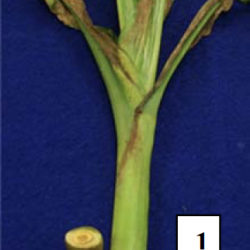
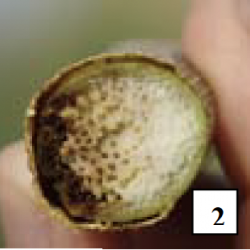
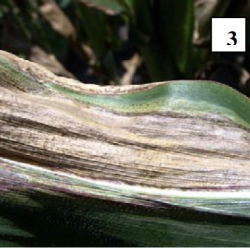
First time detectable characteristic of Goss’s Wilt is the development of dark green black water‐soaked looking spots which appear like freckles near the edges of expanding lesions.
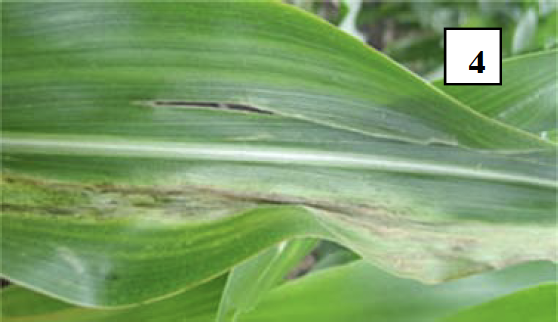
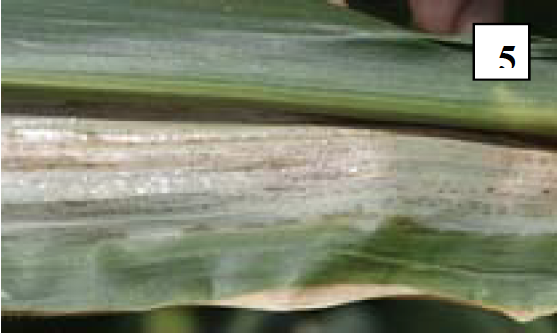
How do I manage Goss’s Wilt?
Tillage related to residue management and crop rotation are good tools to use to help manage the disease. Some weeds including green foxtail, barnyard grass and shattercane are alternative hosts for the disease and should be controlled to reduce the potential for Goss’s Wilt problems. Since Goss’s Wilt is a bacteria and not a fungus, foliar fungicide applications will not provide control of Goss’s Wilt. At this time no corn hybrid has been proven to be 100% resistant to Goss’s Wilt; however, some varieties offer greater tolerance to the disease and the leaf or foliar lesions it causes. Plants need healthy green leaf tissue to perform photosynthesis which in turn creates the sugars needed for good grain fill. Less sugar production due to less available leaf surface forces the corn plant to cannibalize its stalk for nutrients in order to try and accomplish as much grain fill as possible. In doing so, a hybrid that is more susceptible to Goss’s Wilt may have more risk of both yield loss and poorer harvest standability.
Pay attention to Hoegemeyer’s Goss’s Wilt Ratings.
One of the qualities Hoegemeyer looks for in the genetics we use is for plant health, one of which is Goss’s Wilt tolerance. For example, the tolerance many of our genetics carry for plant health and Goss’s Wilt tolerance was visually evident at the 2011 Husker Harvest Days plot demonstrations. In the above picture are nine different small plot company strips from nine different seed companies. Each company has multiple hybrids planted in their strip. Hoegemeyer hybrids are planted in the far left strip which is green yet mainly because of the plant health and the lack of Goss’s Wilt; just one of the many criteria Hoegemeyer looks for when making hybrid selections.
Here is a close up view from the picture above of Hoegemeyer’s 6 plot entries on the right as compared to the competitor’s entries on the left. Hoegemeyer hybrid entries you are seeing in this plot ranged from 107 days to 114 days. The plot hybrids are 2 rows each of brand: 7711 Hx/LL/RR™ – 7998 Hx/LL/RR™ – 8102 Hx/LL/RR™ – 8228 Hx/LL/RR™ – 8345 Hx/LL/RR™ and 8389 HXT/LL/RR™.
Sources and Photo credits:
University of Nebraska, Iowa State University, Purdue University® HPT is a registered trademark of Pioneer Hi‐Bred. HPT® brand seed is distributed by Hoegemeyer Hybrids.Herculex® Insect Protection technology by Dow AgroSciences and Pioneer Hi‐Bred.® Herculex and the HX logo are registered trademarks of Dow AgroSciences LLC. Ignite®, LibertyLink and the Water Droplet Design are trademarks of Bayer.® Roundup Ready is a registered trademark used under license from Monsanto Company. ®, ™ trademarks of Hoegemeyer Hybrids. ©2011 Hoegemeyer Hybrids.
